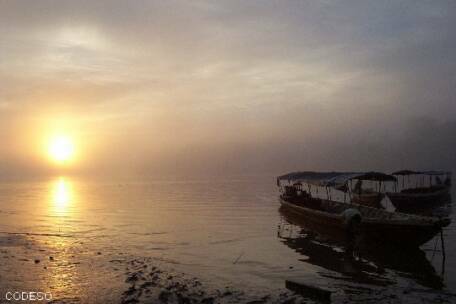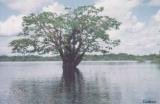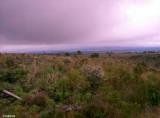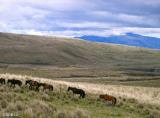Tourism in dem Reservat Cayambe Coca
Tourism in dem Reservat Cayambe Coca
CI
Cayambe Coca Ecological Reserve
The Cayambe Coca Ecological Reserve has an area of 403,103 ha. and was created on November 20, 1970. Most of the reserve is in the Napo province, and another in Sucumbíos, Pichincha and Imbabura.
The Cayambe Coca Ecological Reserve is hilled in the south with the Antisana Ecological Reserve and in the east with the Sumaco National Park or in turn with the Sumaco Galeras Biosphere.
Foto: Río Coca
Guided by its name, it could be said that the Cayambe-Coca National Park protects the Cayambe snow-capped volcano and the sources of the Coca River, but in truth, this is more of a national water park. There is water everywhere, in the environment due to the constant mist and rain, in the vegetation and leaf litter on the ground, in the wetlands and lagoons in the upper part, in the soil and pads of the páramo, and in the rivers. that form falls and cascades.
In the upper part there are famous springs of thermal and mineral waters such as those of Papallacta and Oyacachi. In this region are the sources of rivers such as the Dué, the Chingual, the Cofanes and the Cabeno that feed the Aguarico, so that together with the Coca they deliver their waters to the great Napo river.
On the other side, towards the western foothills, is home to hundreds of springs that feed the Mira and Esmeraldas rivers that flow into the Pacific Ocean.
Gran Sumaco Provincia Napo Areas Protegidas
SITIOS INTERESANTES
- The Reserve begins in the north on the slopes of Nevado Cayambe in the Cayambe canton.
- The Reserve borders the Coca River, which comes from the north.
- The city of Coca is not close to the Cayambe Coca Ecological Reserve.
- There are professional guides in Tena who can accompany you inside the protected areas.
Other Natural o Protected Areas and Spots
Galapagos - Llanganates - Ilinizas - Chimborazo - Sangay - Yasuni - Cuyabeno - Machalilla - Cotopaxi
- The Otavalo handicrafts fair makes this Imbabura town famous. The fairs are every Saturday, but it is worth visiting any day of the week.
- The Peguche Waterfall is located ten minutes north of Otavalo and is one of the natural and spiritual scenes of the area.
- San Miguel de Ibarra, the "White City", is the head of the Imbabura province. Ibarra is known for its wood and leather handicrafts, its blackberry arrope and paila ice cream.
- The city and canton of Cayambe together with Nevado Cayambe.
- Guayllabamba is famous for the "Zoológico de Quito". Guayllabamba is between Cayambe and Quito.
- The Cotacachi Cayapas Ecological Reserve is accessible from the city of Cotacachi. The Reserve has a surface area of 204,420 ha.
Lagunas Cuyabeno Provincia Sucumbios Areas Protegidas
Cotopaxi Paramo Areas Protegidas
Caballos Cotopaxi Parque Nacional
Áreas Protegidas
Reserva Ecológica Arenillas
The park is home to 100 species of endemic plants, 200 species of mammals, 900 birds, 140 reptiles and 116 amphibians spread throughout its ecosystems. In the great plains of the páramo close to the lagoons or where the pajonal is mixed with bushes lined with hair to withstand the cold, you can see cervicabras and rabbits jumping between the pajonales, and the curiquingue or the páramo partridge walking slowly.
Andean weasels or chucuris slide through the vegetation, like some parameros mice, among which there is an aquatic one. Among the largest are the white-tailed deer, the spectacled bear, and the mountain tapir. In the skies you can see hawks, curiquingues and Andean condors, and ducks and seagulls swim in the lagoons. At nightfall, the páramo wolves and skunks begin to appear.
The forests of paper trees or yagual that get tangled up with each other and barely leave room to walk, are mixed with patches of plants such as the taruga, the chicory, the chuquiragua, the romerillo, the lycopodium and the achupalla.
When descending, the Andean forest is found in all its splendor, which shows trees such as pumamaquis, colcas, suros, olive trees, cedars, guabos and alders, which begin to cover themselves with mosses and ferns.
There are also large tree ferns. In these forests live the Andean toucan, the mountain guan and the quetzal. Near the waterfalls, on the rocky slopes, the roosters of the rock nest, very colorful red-crested birds that at dawn and at night do a reproductive dance accompanied by their loud squawks. Among the river rocks are Torrent ducks and white-capped dippers.
In the lower area of the park there are macaws, parrots, toucans, king vultures, guantas, agoutis, tapirs, cuchuchos, mate heads, cusumbos and a great variety of monkeys such as chichicos, night monkeys, spider and howler monkeys.
There are also the conspicuous flowers of the heliconias or platanillos and anthuriums, and palms such as the chambira, the chonta and the palmito. Here the trees grow taller, with larger leaves, and the temperature rises, announcing the entrance to the Amazon.
From Quito
Take the north Pan-American highway until you reach the city of Cayambe (78 km). From here you can access the following places:
To the Cayambe Refuge. Take the second order road Juan Montalvo - El Hato - Pie Monte that leads to the refuge. It takes 45 minutes to the control point along a road that at certain times requires the use of a 4x4 vehicle.
To Oyacachi. Take the road that leads to the Cangahua sector. From here you travel 40 kilometers along a secondary road until you reach the Control Point. 15 minutes from this place is the town of Oyacachi.
For places that are to the east, take the road Quito - Papallacta - El Chaco. From here you can access the following places:
Bathrooms sector. In Papallacta, next to the hot springs area, take a second-order road (5 km) that leads to the checkpoint and access to the trails.
San Rafael waterfall. From the town of El Chaco to the entrance to the waterfall there are 50 kilometers, the closest town before arriving is San Luis.
Fuente: areasprotegidas.ambiente.gob.ec









